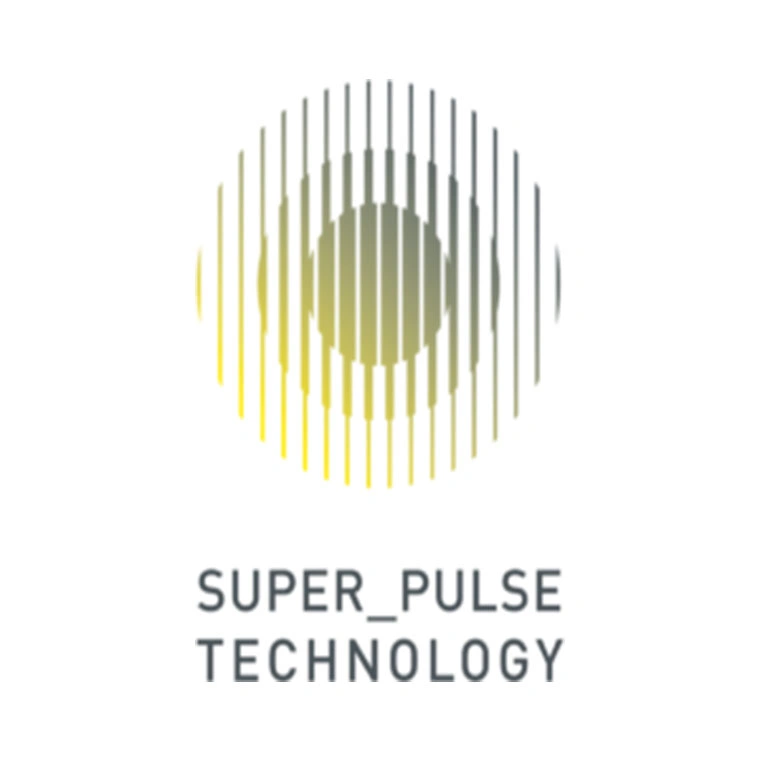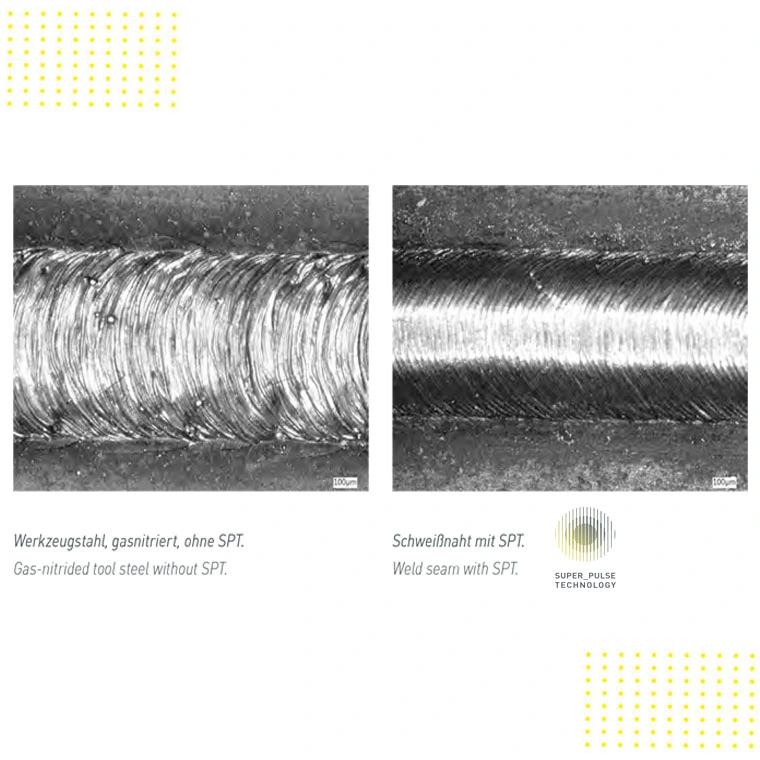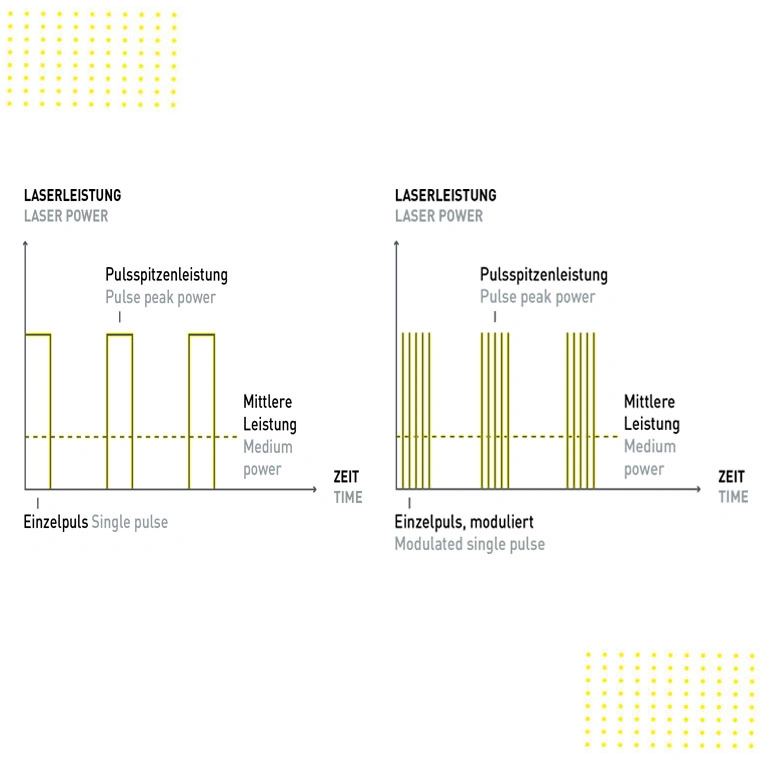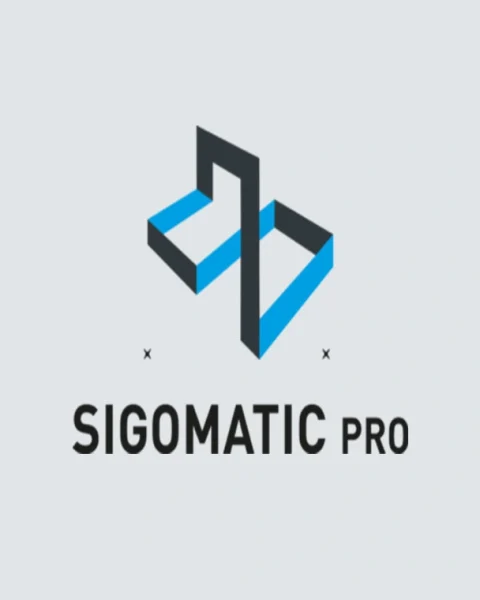Advanced Pulse ModulationSuper Pulse Technology (SPT)
Advanced Pulse Modulation for Precision Laser Welding | Sigma Laser
Super Pulse Technology (SPT) by Sigma Laser is a proprietary innovation that transforms precision laser welding. Designed to modulate energy delivery into the weld pool, SPT enables superior control over heat input, solidification, and grain structure making it the ideal solution for high-performance applications involving complex materials.
At the heart of Sigma Laser’s technological leadership is Super Pulse Technology (SPT)—a patented pulse modulation system that allows unmatched control over laser welding dynamics. Traditional pulsed laser systems often introduce excessive peak power, leading to weld seam defects, overheating, or micro-cracks.
SPT solves these issues by giving operators fine-tuned control over pulse shape, melting bath temperature, and solidification behavior. Whether you’re welding titanium, stainless steel, aluminium, or refractory alloys, SPT ensures superior metallurgical results with homogeneous, fine-grained welds and minimal post-processing.
This technology is especially vital for industries like medical device manufacturing, aerospace, toolmaking, and additive repairs, where material sensitivity and microstructure integrity are paramount.
Engineered for precision WeldingTechnical Breakdown of Super Pulse Technology (SPT)
Super Pulse Technology (SPT) is a game-changing innovation by Sigma Laser that enhances the precision, control, and quality of laser welding by introducing advanced pulse modulation capabilities. Unlike conventional continuous-wave (CW) or standard pulsed laser systems, SPT enables users to finely tailor the thermal energy delivered into the weld zone—resulting in improved material compatibility, structural integrity, and minimal thermal distortion.
Below is a detailed breakdown of the key technological features:
Advanced Pulse Modulation
Instead of relying on fixed pulse profiles, SPT allows complete customization of the pulse shape, duration, and energy distribution, offering optimal control over heat input. This eliminates common issues like overheating, spatter, and weld defects.
Dynamic Melt Pool Temperature Control
Operators can precisely adjust the melt pool temperature in real-time, optimizing it for specific materials. This significantly reduces the risk of burn-through, incomplete fusion, or metal fatigue.
Controlled Solidification & Grain Refinement
SPT gives users control over the nucleation rate and solidification morphology, producing weld seams that are homogeneous, fine-grained, and structurally stable—especially critical in aerospace, medical, and precision tooling.
Improved Ductility for Dissimilar Material Welding
Welding different materials like aluminium to stainless steel or titanium to copper is challenging due to differing thermal behaviors. SPT enhances plastic ductility, reducing the chance of microcracks and improving mechanical bonding.
Integration with Sigomatic Pro
SPT is fully integrated with the Sigomatic Pro control software, ensuring real-time process feedback, adaptive control, and seamless usability without external modules or hardware upgrades.
Compatibility with Refractory and High-Carbon Materials
Welding brittle or sensitive materials such as Inconel, Tantalum, Titanium alloys, and high-carbon steels becomes practical and efficient. SPT avoids heat-affected zone cracking and allows crack-free welds even on difficult surfaces.
Versatility Across Pulse Modes
SPT enhances both pulsed laser and continuous wave (CW) modes. In CW, it reduces unnecessary energy dispersion. In pulsed mode, it adds shape control to each pulse, yielding supercooled, high-quality welds.
User Benefits at a Glance:
- Ultra-precise energy delivery
- Less heat input = Less distortion
- Higher-quality welds with reduced post-processing
- Increased yield in difficult materials
- Greater repeatability and lower error rate
- No need for additional hardware — software-based optimization
Why SPT Outperforms Other SystemsComparison: SPT vs Traditional Pulse/CW Systems
Introduction
When it comes to industrial laser welding, not all laser systems are created equal. Traditional Continuous Wave (CW) and standard pulsed lasers have served various manufacturing needs for decades, but as demands for precision, material compatibility, and microstructural control grow, their limitations become evident.
Super Pulse Technology (SPT) by Sigma Laser represents a new generation of laser processing—enabling advanced control over the entire welding process, from heat input to solidification dynamics. This results in superior weld quality, enhanced flexibility, and minimized post-processing.
Why Super Pulse Technology Outperforms Conventional Systems?
-
Precision Heat Input Control
While traditional pulsed lasers deliver fixed energy bursts, SPT allows dynamic pulse modulation, enabling precise heat targeting based on material properties. This prevents overheating, burn-through, or melt pool instability. -
Optimized Weld Microstructure
Standard systems often lead to coarse-grained welds prone to cracking. SPT modulates the nucleation and solidification rate, producing homogeneous, fine-grained structures with higher ductility and strength. -
Superior Material Compatibility
SPT is uniquely suited for high-temperature resistant alloys, brittle steels, and dissimilar materials. Traditional systems often struggle or fail in these scenarios due to uncontrolled thermal profiles. -
Enhanced Control with Sigomatic Software
SPT integrates seamlessly with Sigma’s proprietary Sigomatic Pro software, offering real-time feedback, advanced waveform design, and parameter memory, allowing reproducibility and automation that basic systems cannot match. -
Minimized Post-Processing
With SPT, the resulting weld seams are cleaner, tighter, and require significantly less polishing or grinding, reducing production time and cost.
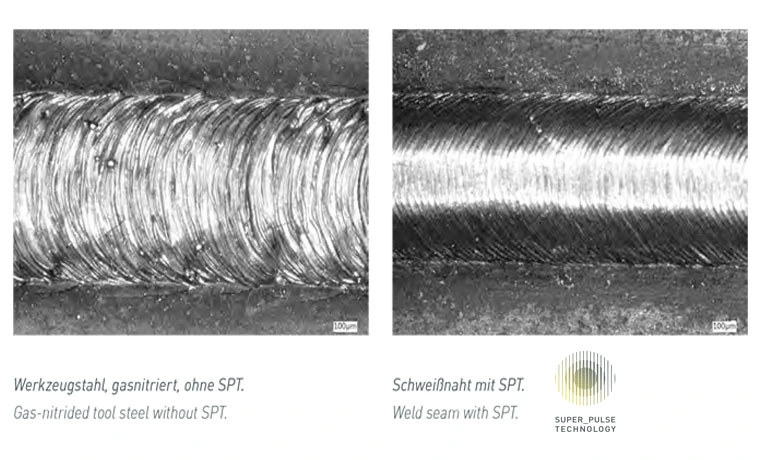
Comparison Table: Super Pulse vs Traditional Laser Modes
Feature |
Super Pulse Technology (SPT) |
Traditional Pulsed Laser |
Continuous Wave (CW) Laser |
Pulse Modulation |
Full, programmable |
Fixed |
Not applicable |
Thermal Control |
Precise, localized |
General heat spread |
High total heat input |
Material Compatibility |
Excellent (even brittle/special alloys) |
Limited to common metals |
Limited, risk of overheating |
Microstructure Control |
Optimized, fine-grained |
Often coarse-grained |
Uncontrolled grain formation |
Weld Seam Quality |
High – minimal defects |
Moderate – cracking possible |
High, but risk of burn-through |
Speed |
High with precision |
Medium |
Very high, but rougher finish |
Post-processing Needed |
Minimal |
Moderate to extensive |
Often extensive |
Best Use Cases |
Complex materials, precision welding |
General industrial applications |
High-speed, high-heat applications |
Why Choose SPT?
If your laser welding applications demand:
- High-performance on difficult materials
- Minimal heat-affected zones
- Superior mechanical and aesthetic weld quality
- Compatibility with automation and smart control systems
- And a clear return on investment from reduced rework…
Then Super Pulse Technology (SPT) is the clear choice.
Sigma Laser’s SPT isn’t just an upgrade—it’s a paradigm shift in laser welding technology.
Where the Super Pulse Technology (SPT) ExcelsIndustrial Applications of Super Pulse Technology (SPT)
Super Pulse Technology (SPT) is engineered to tackle the most demanding laser welding challenges across diverse industries. Its advanced control over heat input, pulse shape, and solidification dynamics makes it ideal for high-precision tasks and difficult-to-weld materials. Below are the key application areas where SPT significantly enhances welding performance:
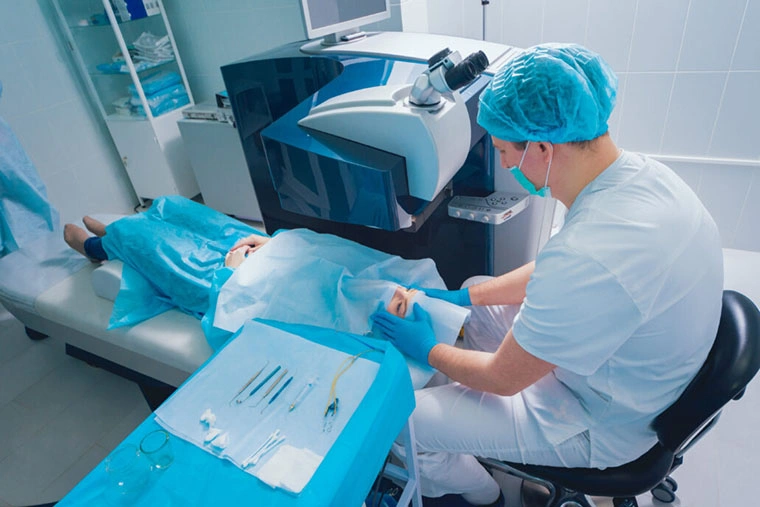
Medical Device Manufacturing
In the medical industry, where precision and material integrity are paramount, SPT enables the welding of biocompatible metals like titanium and stainless steel with ultra-fine control. The result is micro-welds with smooth seams, minimal thermal distortion, and no contamination—critical for implants, surgical tools, and diagnostic devices.
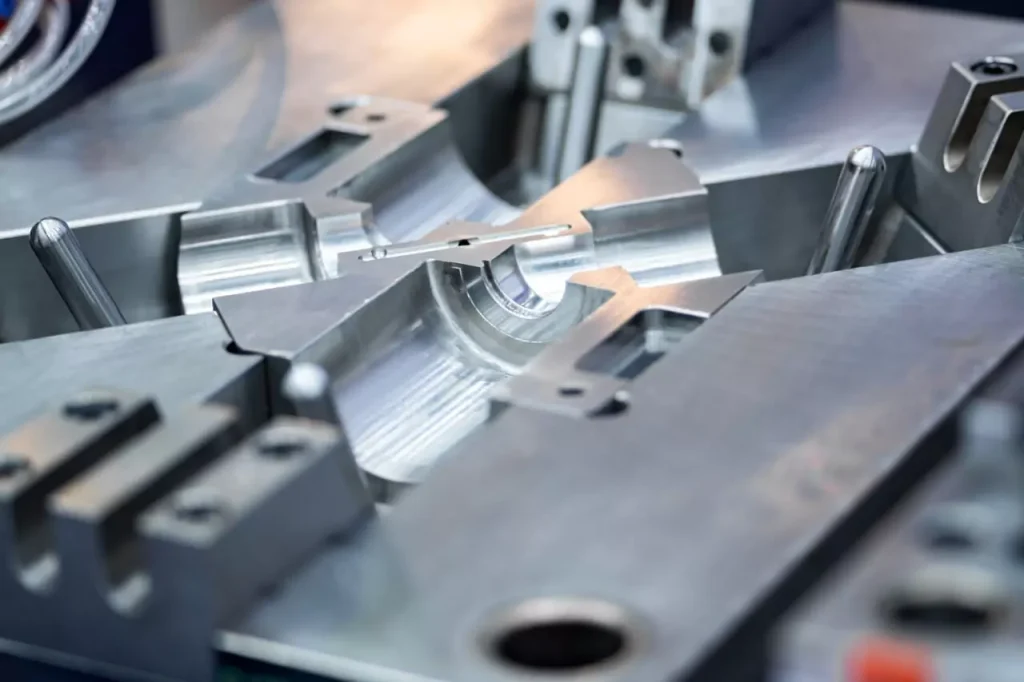
Tool & Mould Making
Welding brittle or hard steels like 1.2379 (D2) often results in cracking with traditional methods. SPT makes it possible to rebuild tools and moulds with flawless seam quality and dimensional accuracy, reducing the need for grinding or heat treatment.

Electronics & Precision Assemblies
SPT's fine energy modulation enables microscale welding without damaging sensitive electronic components. It’s ideal for battery welding, sensor housings, and micro-circuit assemblies where conventional lasers may overheat the substrate.

Jewelry and Watchmaking
For delicate items made from precious metals, SPT enables aesthetic welds with minimal polishing and precise material handling—critical in luxury manufacturing.

Aerospace & Aviation Components
SPT provides the grain refinement and crack resistance needed for welding titanium alloys, Inconel, and aluminium parts used in jet engines and structural components. Its ability to reduce post-processing and improve fatigue life is a major asset in aerospace production.

Automotive & E-Mobility Applications
When welding components like battery modules, drive units, and heat exchangers, SPT offers strong joints with reduced HAZ (heat-affected zone). It also supports welding dissimilar materials commonly found in electric vehicles.
Key Advantages Across Applications:
- Superior weld quality on challenging materials like Inconel, titanium, and tool steel
- Minimal distortion – perfect for precision and delicate components
- Optimized grain structure and enhanced joint ductility
- Increased production yield by reducing rework and post-processing
- Compatible with small-scale, medium, and mass production workflows
- Environmentally friendly – reduced energy input and minimal waste
- Enhanced material bonding for dissimilar metal welding
Built to Match Your Production NeedsCustomization Options of Laser Welding Super Pulse Technology (SPT)
Tailored Laser Modulation for Every Application
One of the most powerful advantages of Super Pulse Technology (SPT) lies in its extensive customizability, making it adaptable to a wide range of industries, materials, and production environments. Unlike rigid, pre-configured laser systems, SPT empowers you to fine-tune every critical aspect of the welding process.
Whether you’re working with high-carbon steels, heat-sensitive alloys, or composite materials, SPT allows you to define custom settings that ensure optimal results every time.
Key Customization Options:
-
Pulse Shape Design
- Create and store complex pulse shapes with multi-stage ramps, plateaus, and drops.
- Achieve greater control over heat input, fusion depth, and weld seam geometry.
-
Energy & Frequency Adjustment
- Precisely adjust peak power, pulse energy, pulse width, and repetition rate for material-specific requirements.
-
Thermal Profile Programming
- Define how heat is introduced and dissipated with real-time temperature modeling.
- Prevent thermal distortion or material warping.
-
Material Presets & Memory Functions
- Pre-configured profiles for commonly used alloys such as titanium, aluminum, Inconel, and tool steels.
- Save and recall welding parameters for repeatable results in series production.
-
Integration with Sigomatic Pro
- Seamless software integration for automated workflows, remote diagnostics, and real-time feedback loops.
-
Compatibility-Based Modulation
- Tailor pulse modulation based on whether you’re using light-pumped Nd:YAG systems or fiber laser sources.
- Switch between CW, pulsed, and SPT-enhanced modes based on project needs.
Smart Modulation Logic
Sigma’s SPT isn’t just customizable—it’s intelligent. With adaptive logic modules, the system can adjust parameters in real time to compensate for surface changes, material inconsistencies, and dynamic part geometries—ensuring unmatched precision and weld consistency.
Customize with Confidence
Whether you’re welding micro-components in medical devices or performing structural repairs in aerospace and tooling, the modular nature of SPT allows you to build a welding system that fits your exact workflow—not the other way around.
FAQsFrequently Asked Questions
Answers to common questions about Super Pulse Technology (SPT):
SPT is a proprietary technology developed by Sigma Laser that allows users to modulate laser pulses in a customized way. Unlike standard pulsed lasers, SPT lets you control pulse shape, frequency, energy, and thermal behavior—enabling superior control over heat input and weld seam quality.
SPT is ideal for critical, heat-sensitive, or brittle materials such as:
- Titanium and its alloys
- Aluminum
- Stainless steels
- Inconel and high-temperature alloys
- High-carbon steels
These materials require fine-grained welds with minimal thermal distortion, which SPT helps achieve.
SPT is specifically designed for pulsed systems, but Sigma Laser platforms allow seamless switching between CW mode, standard pulsed mode, and SPT-enhanced mode, depending on the material and welding task.
Absolutely. Thanks to programmable settings, repeatable pulse profiles, and full software integration with Sigomatic Pro, SPT offers excellent performance and consistency in series production, medical device manufacturing, and toolmaking industries.
By controlling the melting bath temperature, solidification rate, and pulse shape, SPT enables:
- Fine-grained microstructures
- Reduced porosity and cracking
- Better material bonding
- Improved surface aesthetics
Yes, most Sigma Laser platforms are designed to support SPT as an upgrade. Contact Sigma’s support team to assess compatibility and receive a tailored integration plan.
Helpful Guides & Articles for Industrial Laser Welding Super Pulse Technology (SPT)
- How to Configure Super Pulse Settings in Sigomatic Pro: Step-by-step instructions to set up and fine-tune pulse shape, frequency, and energy for different materials.
- SPT Pulse Modulation vs. Conventional Pulsing: A Practical Comparison: A deep dive into how modulated pulse profiles improve weld quality, reduce distortion, and optimize energy input.
- Welding Titanium and Other Reactive Metals Using SPT: Best practices for using Super Pulse Technology in aerospace and medical applications requiring critical precision.
- Overcoming Common Weld Seam Defects with SPT: Learn how to prevent issues like porosity, overheating, and cracking by applying tailored pulse shaping.
- How to Switch Between CW, Pulsed, and SPT Modes on Sigma Laser Systems: A user-friendly guide for navigating between laser modes to match your specific welding needs.
- Understanding Thermal Behavior in Metal Welding with Super Pulse: A technical explanation of how SPT improves thermal control and enhances metallurgical structure.
- Welding High-Carbon and Tool Steels with Super Pulse Technology: Tips for achieving high-strength, crack-free welds on demanding materials used in mould and die production.
- Integrating SPT in Automated Welding Workflows: Learn how SPT works in tandem with robotic arms and motion control systems to support Industry 4.0-ready production.
Long-Term Support You Can Rely OnAfter-Sales Services of Super Pulse Technology (SPT)
At Sigma Laser, our commitment to excellence doesn’t end at delivery. The Super Pulse Technology (SPT) comes with a full suite of after-sales services designed to ensure optimal performance, operator confidence, and long-term value from your investment. Whether you’re a small workshop or a multinational manufacturer, our support ecosystem keeps your production running smoothly.
Performance Optimization Consulting
For customers with high-throughput needs or complex applications, we offer:
- Process auditing
- Automation optimization
- Custom software macros
- Fixture design and integration consulting
Installation & Commissioning
Our team provides on-site setup, system calibration, and full integration into your existing workspace or automation line. We ensure everything is optimized from day one — including safety checks, software configuration, and trial welds.
Spare Parts & Consumables
We maintain a well-stocked inventory of Replacement lamps, Optical components, Cooling units and Wear parts. Fast shipping worldwide ensures minimal downtime.
Remote Diagnostics & Global Support
From preventive maintenance to rapid troubleshooting, our global service team keeps your laser welding equipment running with minimal downtime through on‑site visits and secure remote diagnostics.
Operator Training & System Onboarding
Hands‑on training programs give your staff the skills to operate, maintain, and optimize Sigma laser welding systems safely and productively right from day one.
Extended Warranty & Lamp Breakage Protection
Enjoy long‑term peace of mind with comprehensive warranty coverage—including exclusive lamp break protection—for all light‑pumped laser welding systems.
Keeping Your Super Pulse Technology (SPT) in Peak ConditionMaintenance Instructions of Super Pulse Technology (SPT)
Proper maintenance of Super Pulse Technology (SPT) ensures consistent pulse modulation, reliable weld quality, and extended system longevity. While SPT is a software-based innovation integrated into Sigma Laser systems, it still requires periodic system-level checks, especially for associated hardware such as lasers, optics, and cooling systems.
Daily Maintenance Tasks
-
Inspect Laser Optics
Clean and check lenses for dust or spatter. Ensure the optical path is unobstructed. -
Pulse Monitoring Logs
Review pulse waveform stability and check for irregularities in modulation output. -
Check Cooling Flow Rate
Ensure stable water or air cooling for temperature-sensitive components. -
Review Active Weld Settings
Confirm correct SPT presets are loaded for each material type.
Weekly Maintenance Checklist
-
SPT Firmware & Software Update Check
Verify that Sigomatic/Sigomatic Pro and the SPT modules are running the latest firmware versions. -
Data Logging Review
Export and analyze weld logs to assess pulse performance trends. -
Inspect Connectors and Wiring
Ensure tight, clean connections between control modules and the main laser system. -
Check for Error Logs or Warnings
Use diagnostic tools to identify any latent issues in SPT processing behavior.
Monthly Maintenance Checklist
-
Calibration of Pulse Timing
Use built-in calibration routines to fine-tune timing and amplitude of pulses. -
Evaluate Weld Quality Consistency
Perform sample weld tests across common materials to verify output reliability. -
Inspect Signal Transmission
Test and verify proper communication between the software interface and pulse modulation unit. -
Thermal Stress Audit
Use thermal imaging (if available) to analyze hotspots in pulse delivery and system electronics.
Long-Term Preventive Maintenance
-
System Audit Every 6 Months
Schedule a full system audit, including waveform profiling and modulation consistency. -
Backup and Archive SPT Configurations
Maintain a secure archive of pulse profiles and configuration presets. -
Review Component Wear
Inspect diodes, lamps, and circuit boards for wear caused by frequent high-frequency operation. -
Training for Operators
Provide periodic refresher training on SPT features, usage, and maintenance to ensure optimal utilization.
Pro Maintenance Tips
-
Use Pulse Monitoring Oscilloscopes
Professionals can benefit from real-time analysis using digital scopes to assess pulse shape, rise time, and falloff. -
Avoid Pulse Overdrive Settings
Continuously operating at max pulse peak can degrade hardware faster—tune for efficiency, not extremes. -
Enable SPT Logging by Default
Always keep logging on for auditability and easier troubleshooting. -
Leverage Sigma Remote Support
Use Sigma’s remote diagnostic tools for instant expert help when anomalies appear.
Summary
Super Pulse Technology (SPT) significantly improves welding performance by allowing granular control over heat input and pulse modulation. While it is robust by design, maintaining it through daily checkups, regular updates, and deep diagnostics will ensure peak performance, reduced downtime, and consistent weld quality across all applications.
Operating the Super Pulse Technology (SPT) with ConfidenceSafety Guidelines for Super Pulse Technology (SPT) in Industrial Laser Welding
Super Pulse Technology (SPT) from Sigma Laser introduces high-frequency pulse modulation with precise thermal control. While it boosts weld performance and material adaptability, it also involves advanced laser dynamics, making laser safety a top priority. Ensuring a safe environment is critical for both personnel protection and equipment longevity.
Laser Safety Classification
-
Laser Class:
Most SPT-equipped systems operate under Class 1 when fully enclosed. However, during maintenance or open operation, Class 4 conditions may apply. -
Beam Hazards:
Pulsed lasers can emit high-energy spikes that pose a severe risk to skin and eyes—even with low average power.
Required Personal Protective Equipment (PPE)
-
Laser Safety Goggles:
Certified for Nd:YAG or fiber wavelengths, depending on the system used (typically 1064nm or 1070nm). -
Heat-Resistant Gloves:
For manual adjustments near weld areas or heated components. -
Protective Lab Coats/Aprons:
Flame-retardant and anti-static clothing is recommended. -
Closed-Toe Shoes:
Industrial-grade shoes to protect against mechanical hazards.
Workspace Safety Requirements
-
Enclosed Welding Stations:
Always use enclosed cabins or laser safety curtains during active welding. -
Proper Ventilation:
Install fume extractors or local exhaust ventilation to remove hazardous emissions. -
Illumination & Signage:
Ensure laser warning signs are posted visibly and ambient lighting does not interfere with laser visibility.
Electrical & Cooling System Safety
-
Power Supply Safety:
Ensure all power sources are grounded and surge-protected. Avoid operating near water or conductive materials. -
Cooling System Checks:
Regularly inspect coolant flow to prevent overheating of pulse control components. -
Leak Detection:
Use leak sensors near laser head and cooling junctions to catch faults early.
Software & Control Warnings
-
SPT Settings Lockout:
Enable admin-only access for modifying SPT pulse parameters to prevent accidental overdriving. -
Soft Stop Emergency Integration:
Configure your Sigomatic system with soft-stop triggers for abnormal pulse behavior. -
Firmware Verification:
Ensure firmware versions are compatible to prevent unintended modulation behaviors.
Emergency Procedures
-
Laser Exposure Incident:
Power down system immediately and seek medical attention for eye/skin exposure. -
Overheat Shutdown:
Follow system-specific shutdown protocol to avoid damage from thermal runaway. -
Fire Suppression:
Keep certified extinguishers (Class D or CO₂) near laser stations.
Training & Access Control
-
Operator Certification:
Only trained and certified personnel should operate SPT-enabled systems. -
Access Restriction:
Lock rooms or access panels when systems are unattended or in maintenance mode. -
Remote Diagnostics:
Use Sigma’s remote support tools responsibly and only by authorized technical staff.
Safety Summary
Super Pulse Technology introduces complex and powerful laser functions that demand strict safety protocols. From personal protective gear and workspace design to software restrictions and emergency plans, every layer of protection enhances operational safety. Adhering to these safety standards ensures that SPT can be leveraged to its full potential—without compromising human or hardware safety.
Revolution in laser weldingWhy Super Pulse Technology is the Future of Precision Laser Welding?
Super Pulse Technology (SPT) by Sigma Laser is not just a feature—it’s a revolution in laser welding precision, safety, and material versatility. By combining advanced pulse modulation, real-time thermal control, and proprietary software integration, SPT empowers manufacturers to overcome the limitations of traditional CW and pulsed laser systems.
Whether you’re working with sensitive alloys, complex geometries, or high-precision components, SPT provides superior weld quality, crack-free joints, and reduced post-processing, all while increasing productivity and safety.
If you’re looking to future-proof your laser welding operations, optimize process control, and gain a competitive edge in demanding industries like aerospace, medical, or toolmaking, then Super Pulse Technology is your ideal solution.

